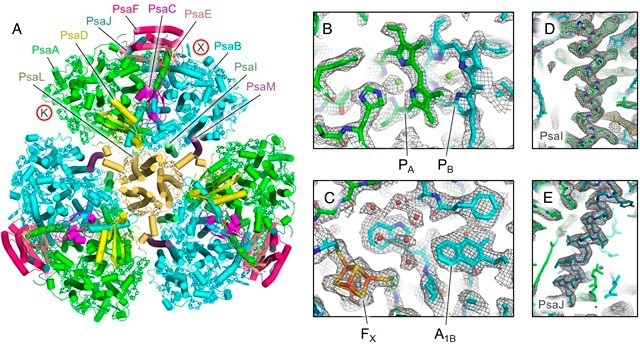Reviewed by Lexie CornerMay 19 2025
An international team of scientists has solved a key piece of Earth’s evolutionary puzzle by uncovering the structure of a light-harvesting nanodevice in one of the planet’s most ancient cyanobacterial lineages. The discovery offers an unprecedented glimpse into how early life harnessed sunlight to produce oxygen, a process that fundamentally transformed the planet.
 A cryo-electron microscopy structure of Photosystem I isolated from the bacterium Anthocerotibacter panamensis. Image Credit: Han-Wei Jiang et al./PNAS
A cryo-electron microscopy structure of Photosystem I isolated from the bacterium Anthocerotibacter panamensis. Image Credit: Han-Wei Jiang et al./PNAS
The team, including Dr. Tanai Cardona from Queen Mary University of London, focused on Photosystem I (PSI) - a molecular complex that converts light into electrical energy - purified from Anthocerotibacter panamensis, a newly discovered species representing a lineage that diverged from all other cyanobacteria around 3 billion years ago.
Remarkably, this living relic has no close relatives; its nearest known evolutionary "sister" species branched off approximately 1.4 billion years ago.
We cannot travel back three billion years to observe the cyanobacteria on Earth. That is why the early-branched A. panamensis is so crucial; it lets us glimpse what occurred in the past.
Dr Ming-Yang Ho, Study Lead Author, National Taiwan University
Most cyanobacteria, as well as all algae and plants, organize their photosynthetic machinery into stacked membrane sheets called thylakoids, which function like multi-layered solar panels. A. panamensis, however, lacks thylakoids, confining its photosynthetic activity to a single membrane layer. This limitation reduces its photosynthetic efficiency, resulting in slow growth and a tolerance for only low-light conditions in laboratory settings.
With this PSI structure in hand. We can compare it to others and see which features are ancient and which are recent evolutionary innovations.
Dr Christopher Gisriel, Study Co-Author, University of Wisconsin-Madison
Despite evolutionary drift in the protein sequences of most bacteria, the team found that the overall architecture of Photosystem I (PSI) in A. panamensis has remained remarkably conserved. Three PSI units form a trimeric structure resembling a three-leaf clover, collectively housing more than 300 light-absorbing pigments, including chlorophylls and carotenoids.
Even three billion years ago, photosynthesis appears to have reached a remarkable degree of sophistication. To find the true origin of oxygen-producing photosynthesis, we’ll have to look even further back, before cyanobacteria themselves evolved.
Dr Tanai Cardona, School of Biological and Behavioural Sciences, Queen Mary University of London
Source:
Journal reference:
Jiang, H.-W., et al. (2025) Structure and evolution of photosystem I in the early-branching cyanobacterium Anthocerotibacter panamensis. Proceedings of the National Academy of Sciences. doi.org/10.1073/pnas.2427090122.